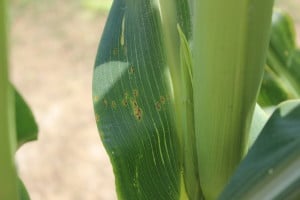This past week samples from Chester, Lauderdale, and Montgomery Counties in Tennessee were confirmed to have southern corn rust, so the question is do you need to put out a fungicide application…
To guide fungicide application decisions one should scout, assess disease level, and growth stage of corn. Most corn will be far enough along with little or no southern rust present to not need to spray, while later planted corn may benefit from an application. Hybrid susceptibility level and if the field is irrigated should also be weighed in, and can increase risk = possible need for fungicide application, but again will depend on growth stage. Corn at R3 and later with low risk should be in the clear (in general); corn at earlier stages and finding southern rust may benefit from application.
While southern corn rust is the one of the most damaging diseases, be sure it is correctly identified and not confused with common rust, which common rust has also been identified in TN. The characteristics that differ between the rusts are the location, color, shape, and distribution of pustules (see Table 1 and images 1 and 2). When in doubt don’t hesitate to contact your local county agent for advice on disease management and identification. Visit corn.ipmpipe.org/southerncornrust/ to see the latest on where southern rust has been reported.
There are multiple fungicides labeled for corn and for the management of different diseases. The multistate collaborative, the Corn Disease Working Group (CDWG), has developed information on fungicide efficacy for control of certain corn diseases. This corn fungicide efficacy table can be found at UTcrops.com (Corn Fungicide Table – CDWG) and linked here as well. Application coverage is also important, which includes using sufficient amount of water per acre and adequate droplet size based on the product being applied.
Table 1. Comparison of Southern and Common Rust
| Pustule Characteristics: | Common Rust | Southern Rust |
| Location | upper and lower leaf surfaces | primarily upper leaf surface |
| Color | brownish, red | orange to light brown |
| Shape | elongated | round |
| Distribution | scattered | densely packed |
| Other differences: | ||
| Optimal Temperature | 61-77 °F | 77-82 °F |
| Probability of Effecting Yield | low | moderate to high |



